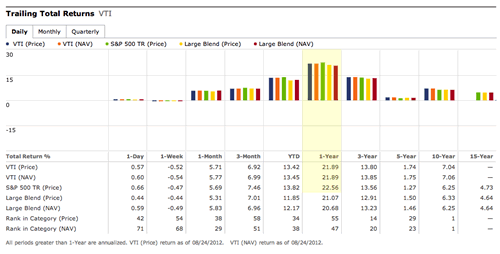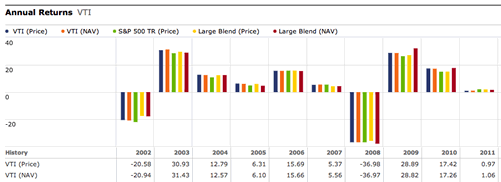I was updating my portfolio spreadsheet over the weekend and noticed that many of my funds have been a quite a roll recently. The trailing one-year total return of the US stock market is over 21%. I don’t know of any market “expert” that called that, do you? Here’s the return data for the Vanguard Total US Market ETF (VTI) via Morningstar:
This brings me to a great quote on “lumpy” asset returns by David Merkel on Aleph Blog:
Asset returns are not what the financial planners tell you. Asset returns are lumpy. They are feast and famine, with more feast than famine, but with enough famine scare a lot of people away. The good returns come when most are scared, and think the market is rigged. The bad returns come after a period of prosperity, and those that don’t understand the market start investing, because it seems to be free money.
In other words, that 8-10% average annual return of the stock market that we always bring up? That never happens. Here are the annual returns of the Total US Market ETF for the last 10 years:
Up, down, up, down. If you’re going to invest in stocks you should expect this erratic behavior and the resulting uncomfortable feelings, and hopefully figure out how to deal with them. I recommend trying to keep things methodical with buy-hold-rebalance.


 The Best Credit Card Bonus Offers – 2025
The Best Credit Card Bonus Offers – 2025 Big List of Free Stocks from Brokerage Apps
Big List of Free Stocks from Brokerage Apps Best Interest Rates on Cash - 2025
Best Interest Rates on Cash - 2025 Free Credit Scores x 3 + Free Credit Monitoring
Free Credit Scores x 3 + Free Credit Monitoring Best No Fee 0% APR Balance Transfer Offers
Best No Fee 0% APR Balance Transfer Offers Little-Known Cellular Data Plans That Can Save Big Money
Little-Known Cellular Data Plans That Can Save Big Money How To Haggle Your Cable or Direct TV Bill
How To Haggle Your Cable or Direct TV Bill Big List of Free Consumer Data Reports (Credit, Rent, Work)
Big List of Free Consumer Data Reports (Credit, Rent, Work)
Very well put. And the secret behind putting the lumpy returns to use is to understand the economic cycle, just in broad strokes. Up markets and down markets don’t flip every month – each tends to be sustained for a while. Sitting out the down cycle is simple technically but hard emotionally. It’s almost like Warren Buffett’s job description: doing nothing. This is not timing the market, it’s sitting out the bad half. If you do that, your returns are WELL over 9%!
Hey William, the next time we have a 50% correction in the stock market please ring a bell when the “bad half” is over so I know when to jump back in. Thanks.
I would disagree with the article’s headline; over time, the market’s returns are literally the definition of their average. Looking back 1 year is not a good timeframe. I prefer to look back 30 years at which point you’ll see that Bogle’s notion of “reversion to the mean” holds true.
How do you blend in tax loss harvesting in the mix?
@William – The past year was supposed to be the bad half, wasn’t it? You know, the one with Greek crisis, dropping interest rates, and oh, 20%+ returns?
@Brian – I agree, but my point is that 8% a year is not 8% every year, and if you expect that you’ll be disappointed. I think many people bail out of the market after a few bad years as they are disillusioned.
@John – You could tax loss harvest between similar but not identical index funds, for example VFINX/VOO and VTSMX/VTI
I like how people (Andy) deride William’s post. It actually makes sense, and is exactly what the author said. When everyone is scared to death, THAT IS WHEN it actually makes sense to invest. Not in any particular stock, but in a broad market fund.
For example, remember when that “50% correction” Andy is talking about happened? I do, it was March 2009. I started putting all the extra cash I could into an S&P fund right around that time, and it’s turned out quite nicely. Now that the market is peaking, probably a good time to cash in on some of those returns.
So, long story short, just as the author said “The good returns come when most are scared, and think the market is rigged.” Thankfully, people like Andy sell when things get tough, which allows people like me to take advantage of that fear by buying at a low price point. This is not “market timing”, it’s common sense.
Well, I invested a lot of money into stocks around March 2009 as well, but that was just due to rebalancing and without emotion or need for timing. S&P 500 went down 40%, which meant I needed to increase my investment by 66% to get back to the original size. It turned out quite well for me as well, but I don’t think it was completely obvious at the time otherwise I should have leveraged myself up and made millions as would others including BRK. I simply like using such wisdom as encouragement to rebalance when the time calls for it.
In any case, I don’t see that much greed in the market right now. I think tops are even harder to call than bottoms.
Agree, tops are much harder than bottoms. But do you remember the mass hysteria in March 2009? Some media reports said the Dow would surely crumble and never return, which if you look at history most would realize this was highly unlikely.
Therefore, it was worth a small gamble to bet that the market would come back. Even if it only came back 10%, you would be up, but it has not exceeded its original peak prior to the bear. I’m not saying that regular investing and rebalancing isn’t the best method, it is. However when you see an obvious market correction opportunity you should take advantage of it to the best of your ability. I would never advocate leveraging yourself though, that is how most get into trouble…the recent real estate crash comes to mind.
Correction***”has exceeded its original peak”